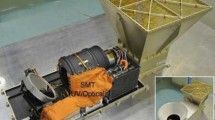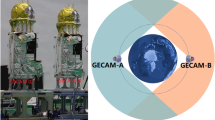Abstract
The main scientific goal of the Gravitational wave high-energy Electromagnetic Counterpart All-sky Monitor (GECAM) is to monitor various types of Gamma-Ray Bursts (GRB) originated from merger of binary compact stars, which could also produce gravitational wave, and collapse of massive stars. In order to study the response of GECAM Gamma-Ray Detectors (GRDs) to high-energy bursts and test the in-flight trigger and localization software of GECAM before the launch, a portable GRB simulator device is designed and implemented based on grid controlled X-ray tube (GCXT) and direct digital synthesis (DDS) technologies. The design of this GRB simulator which modulates X-ray flux powered by high voltage up to 20 kV is demonstrated, and the time jitter (FWHM) of the device is about 0.9 μs. Before the launch in December, 2020, both two GECAM satellites were irradiated by different types of GRBs (including short and long bursts in duration) generated by this GRB simulator. The light curves detected with GECAM/GRDs are consistent with the programmed input functions within statistical uncertainties, indicating the good performance of both the GRDs and the GRB simulator.












Similar content being viewed by others
References
Dai, Z., Wu, X., Liang, E., et al.: How to understand high-energy gamma-ray bursts? Chin. Sci. Bull. 63(24), 6 (2018). in Chinese. https://doi.org/10.1360/N972018-00034
Kouveliotou, C., Meegan, C.A, Fishman, G.J: oters Identification of two classes of gamma-ray bursts. Astrophys. J. 413, L101–L104 (1993). https://doi.org/10.1086/186969
P. Abbott, B., Abbott, R., D. Abbott, T., et al.: Gravitational waves and gamma-rays from a binary neutron star merger: GW170817 and GRB 170817A. Astrophys. J. Lett. 848(2), L13 (2017). https://doi.org/10.3847/2041-8213/aa920c
Goldstein, A., Veres, P., Burns, E., et al.: An ordinary short gamma-ray burst with extraordinary implications: Fermi-GBM detection of GRB 170817A. Astrophys. J. Lett. 848(2), L14 (2017). https://doi.org/10.3847/2041-8213/aa8f41
Xiong, S.: Special topic: GECAM gamma-ray all-sky monitor. Sci. Sin. Phys. Mech. Astron. 50(12), 129501 (2020, in Chinese). https://doi.org/10.1360/SSPMA-2020-0457
Zhang, D., Li, X., Xiong, S., et al.: Energy response of GECAM gamma-ray detector based on LaBr3:Ce and SiPM array. Nucl. Instrum. Methods Phys. Res. A 921, 8–13 (2019). https://doi.org/10.1016/j.nima.2018.12.032
Lv, P., Xiong, S.L., Sun, X.L., et al.: A low-energy sensitive compact gamma-ray detector based on LaBr3 and SiPM for GECAM. J. Instrum. 13 (08), P08014 (2018). https://doi.org/10.1088/1748-0221/13/08/P08014
Bissaldi, E., von Kienlin, A., Lichti, G., et al.: Ground-based calibration and characterization of the Fermi gamma-ray burst monitor detectors. Exper. Astron. 24(1-3), 47–88 (2009). https://doi.org/10.1007/s10686-008-9135-4
Sato, E., Ichimaru, T., Usuki, T., et al.: Condenser-discharge stroboscopic x-ray generator SX-C98. In: 23rd International Congress on High-Speed Photography and Photonics. https://doi.org/10.1117/12.350542, vol. 3516, pp 618–625. International Society for Optics and Photonics (1999)
Hu, H., Zhao, B., Sheng, L., et al.: A simulation experiment system for X-ray pulsar based navigation. Acta Physica Sinica 60(2), 029701 (2011). in Chinese. https://doi.org/10.7498/aps.60.029701
Sheng, L., Zhao, B., Liu, Y.: Novel space communication technology based on modulated x-ray source. In: Morawe, C., Khounsary, A.M., Goto, S. (eds.) Advances in X-Ray/EUV Optics and Components IX. https://doi.org/10.1117/12.2062712, vol. 9207, pp 278–284. International Society for Optics and Photonics, SPIE (2014)
Zhou, F., Wu, G., Zhao, B., et al.: An analog modulated simulation source for X-ray pulsar-based navigation. Acta Physica Sinica 62(11), 119701 (2013). in Chinese. https://doi.org/10.7498/aps.62.119701
Lizhi, S.: Research of Key Technologies for X-ray Pulsar Simulation and X-ray Detector. PhD thesis, Beijing: University of Chinese Academy of Sciences (2013)
Li, X., Wen, X., Sun, X., et al.: The GECAM and its payload. Sci. Sin.: Phys. Mech. Astron. 50(12), 129508 (2020). in Chinese. https://doi.org/10.1360/SSPMA-2019-0417
ADI. Datasheet of ADHV4702-1. https://www.analog.com/media/en/technical-documentation/data-sheets/ADHV4702-1.pdf, Accessed 8 March 2021
Vankka, J.: Methods of mapping from phase to sine amplitude in direct digital synthesis. IEEE Trans Ultrason Ferroelectr Freq Control 44(2), 526–534 (1997). https://doi.org/10.1109/58.585137
Golkhou, V.Z., Butler, N.R., Littlejohns, O.M.: The energy dependence of grb minimum variability timescales. Astrophys. J. 811(2), 93 (2015). https://doi.org/10.1088/0004-637X/811/2/93
Carmel. Datasheet of NK732. https://www.carmelinst.com/images/NK732_Datasheet.pdf, Accessed 8 March 2021
Nian, Y., Yupeng, X., Jia, H., et al.: A random signal emulator for silicon drift detector based FPGA. Nuclear Techniques 43(8), 80–85 (2020). in Chinese. https://doi.org/10.11889/j.0253-3219.2020.hjs.43.080402
Fenimore, E.E., Madras, C.D., Nayakshin, S.: Expanding relativistic shells and gamma-ray burst temporal structure. Astrophys. J. 473(2), 998 (1996). https://doi.org/10.1086/178210
EE Fenimore, JP, Norris, JT, et al.: Bonnell Gamma-ray burst peak duration as a function of energy. Astrophys. J. Lett. 448(2), L101 (1995). https://doi.org/10.1086/309603
Link, B., Epstein, R.I, Priedhorsky, W.C: Prevalent properties of gamma-ray burst variability. Astrophys. J. 408, L81–L84 (1993). https://doi.org/10.1086/186836
Band, D.L.: Gamma-ray burst spectral evolution through cross-correlations of discriminator light curves. Astrophys. J. 486(2), 928 (1997). https://doi.org/10.1086/304566
Muleri, F., Baldini, L., Baumgartner, W., et al.: Calibrating the IXPE observatory from ground to space. In: UV, X-Ray, and Gamma-Ray Space Instrumentation for Astronomy XX. https://doi.org/10.1117/12.2275133, vol. 10397, p 103970G. International Society for Optics and Photonics (2017)
Golkhou, V.Z., Butler, N.R.: Uncovering the intrinsic variability of gamma-ray bursts. Astrophys. J. 787(1), 90 (2014). https://doi.org/10.1088/0004-637X/787/1/90
Kocevski, D., Butler, N., Bloom, J.S: Pulse width evolution of late-time x-ray flares in gamma-ray bursts. Astrophys. J. 667(2), 1024 (2007). https://doi.org/10.1086/520041
Pal’shin, V.D., Hurley, K., Svinkin, D.S., et al.: Interplanetary network localizations of konus short gamma-ray bursts. Astrophys. J. Suppl. Ser. 207(2), 38 (2013). https://doi.org/10.1088/0067-0049/207/2/38
Hurley, K., Briggs, M.S., Kippen, R.M., et al.: The interplanetary network supplement to the burst and transient source experiment 5B catalog of cosmic gamma-ray bursts. Astrophys. J. Suppl. Ser. 196(1), 1 (2011). https://doi.org/10.1088/0067-0049/196/1/1
Hurley, K., Briggs, M.S., Kippen, R.M., et al.: The ulysses supplement to the BATSE 4Br catalog of cosmic gamma-ray bursts. Astrophys. J. Suppl. Ser. 122(2), 497 (1999). https://doi.org/10.1086/313220
Zhao, Z., Wang, Y., Zhang, L., et al.: Experiments and simulation of X-ray optical Wolter-I focusing mirror. Opt. Precis. Eng. 027(011), 2330–2336 (2019). in Chinese. https://doi.org/10.3788/OPE.20192711.2330
Acknowledgements
This research is supported by the Strategic Priority Program on Space Science, the Chinese Academy of Sciences, Grant No. XDA15020501, No. XDA1531010301 and No. XDA15360102. We are also grateful to Shanghai KEYWAY ELECTRON Technology Co., Ltd for their assistance in the processing and design of X-ray tubes.
Author information
Authors and Affiliations
Corresponding authors
Ethics declarations
Conflict of Interests
The authors declare that they have no conflict of interest.
Additional information
Publisher’s note
Springer Nature remains neutral with regard to jurisdictional claims in published maps and institutional affiliations.
Rights and permissions
About this article
Cite this article
Chen, C., Xiao, S., Xiong, S. et al. Design and test of a portable Gamma-Ray Burst simulator for GECAM. Exp Astron 52, 45–58 (2021). https://doi.org/10.1007/s10686-021-09776-y
Received:
Accepted:
Published:
Issue Date:
DOI: https://doi.org/10.1007/s10686-021-09776-y




